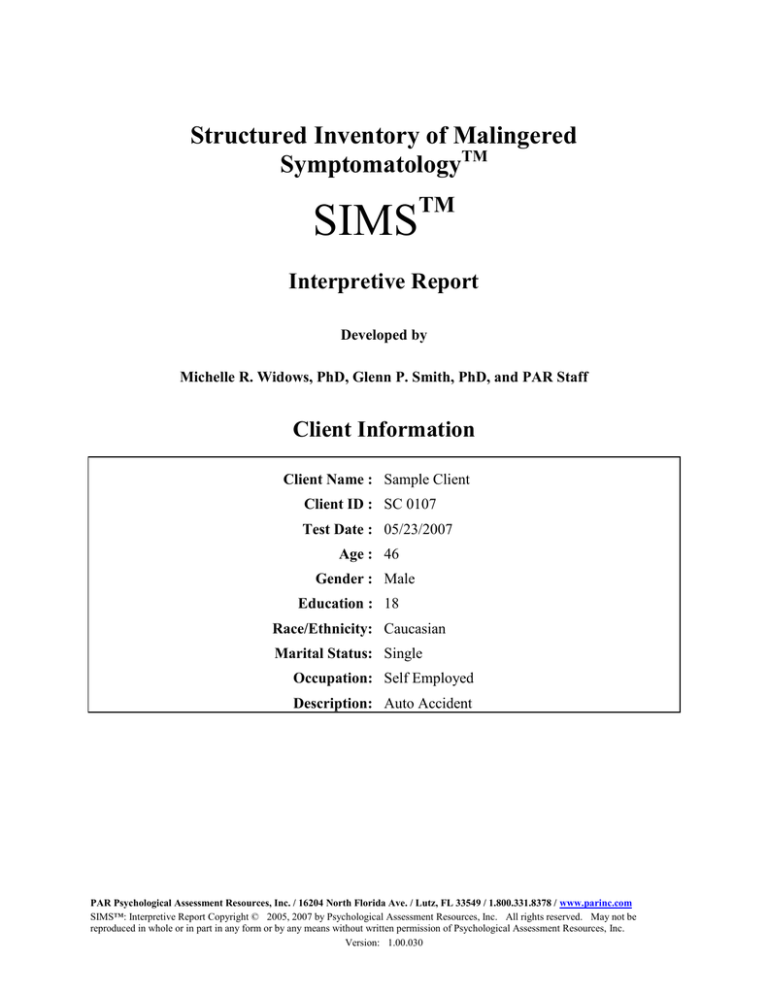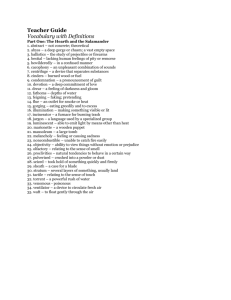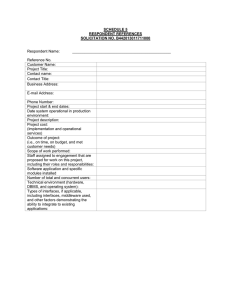
Structured Inventory of Malingered
SymptomatologyTM
SIMS
TM
Interpretive Report
Developed by
Michelle R. Widows, PhD, Glenn P. Smith, PhD, and PAR Staff
Client Information
Client Name : Sample Client
Client ID : SC 0107
Test Date : 05/23/2007
Age : 46
Gender : Male
Education : 18
Race/Ethnicity: Caucasian
Marital Status: Single
Occupation: Self Employed
Description: Auto Accident
PAR Psychological Assessment Resources, Inc. / 16204 North Florida Ave. / Lutz, FL 33549 / 1.800.331.8378 / www.parinc.com
SIMS™: Interpretive Report Copyright © 2005, 2007 by Psychological Assessment Resources, Inc. All rights reserved. May not be
reproduced in whole or in part in any form or by any means without written permission of Psychological Assessment Resources, Inc.
Version: 1.00.030
Administrative Information
Location of Testing: Dr Smith's office
Context/Setting: Private Office
Purpose of Testing: Disability
Reported Symptoms: Cognitive
PAR Psychological Assessment Resources, Inc. / 16204 North Florida Ave. / Lutz, FL 33549 / 1.800.331.8378 / www.parinc.com
SIMS™: Interpretive Report Copyright © 2005, 2007 by Psychological Assessment Resources, Inc. All rights reserved. May not be
reproduced in whole or in part in any form or by any means without written permission of Psychological Assessment Resources, Inc.
Version: 1.00.030
Introduction
The Structured Inventory of Malingered Symptomatology™ (SIMS™) is a multi-axial,
self-administered measure developed to serve as a screening tool for the detection of feigned or
exaggerated psychiatric disturbance and cognitive dysfunction among adults ages 18 years and
older across a variety of clinical and forensic settings. The SIMS consists of 75 items that yield a
summary score reflective of a general feigning presentation (Total score), as well as five
nonoverlapping scales that reflect theoretical and statistical considerations of the more
commonly feigned or exaggerated disorders: (a) Psychosis, (b) Neurologic Impairment, (c)
Amnestic Disorders, (d) Low Intelligence, and (e) Affective Disorders.
The SIMS is intended to serve multiple functions as (a) an initial screening tool for individuals
who may not otherwise be referred for specific evaluation of potential feigning within a forensic
or medico-legal context or setting; (b) an initial screening tool for individuals suspected of
feigning to determine the need for more extensive evaluation; and (c) convergent data in a
comprehensive evaluation for potential feigning. The SIMS’ brief, easily administered self-report
format and fifth-grade reading level reduce clinician burden and allow for completion by a wide
range of individuals at varying educational/cognitive levels.
Interpretive Caveats
This report is confidential and intended for use by qualified professionals only. This report
should not be released to the individual being evaluated. A thorough understanding of the SIMS,
including its development and its psychometric properties, is a prerequisite to interpretation. As
with any clinical method or procedure, the utility and validity of the SIMS is dependent on the
qualifications and competencies of the professional(s) who use the instrument.
Cutoff scores are used to interpret the level of feigned or exaggerated symptoms as presented by
the respondent. SIMS Total and scale cutoff scores were statistically derived by validation and
cross-validation samples and have been further validated by independent researchers with
clinical forensic samples, psychiatric samples, and nonclinical samples. Validation samples have
included adults of both genders, various racial/ethnic backgrounds, and a wide range of ages. As
a result, the SIMS is appropriate for the screening of malingered psychiatric and cognitive
complaints in a wide range of contexts (e.g., forensic, neuropsychological, medico-legal) and in a
wide variety of settings (e.g., inpatient, outpatient, correctional).
The SIMS is not intended to serve as a diagnostic tool for feigning in isolation. Individuals
identified as potential malingerers through the use of the SIMS should be referred for more
extensive assessment. A determination of feigning should be made in the context of a
comprehensive evaluation only, whereby multiple sources of data (e.g., psychosocial,
psychiatric, and medical history; clinical interview; comparison of subjective reports of
symptoms to objective information and observations; results from feigning-specific and
psychological inventories) as well as multiple assessment devices (e.g., structured interviews,
performance based tests) are employed in order to provide convergent and corroborative data in
making a definitive classification of feigning.
Although the determination of feigning is dependent upon the discrimination between actual
versus feigned or exaggerated symptoms, it does not preclude the presence of another disorder.
As such, the suggestion of probable feigning using the SIMS should not negate the possibility of
genuine disability or disorder.
Profile of SIMS™ Scores
Scales
Total
75
75
15
15
70
70
14
14
65
65
13
13
60
60
12
12
55
55
11
11
50
50
10
10
45
45
9
9
40
40
8
8
35
35
7
7
30
30
6
6
25
25
5
5
20
20
4
4
15
15
3
3
10
10
2
2
5
5
1
1
0
0
TOTAL
Score
Missing
21
0
0
0
Psychosis
Score
Missing
Frequency
Percent (%)
0
---
True
n/a
n/a
Neurologic
Impairment
6
---
False
n/a
n/a
Amnestic
Disorders
8
---
Low
Intelligence
3
---
Missing
0
0
Affective
Disorders
4
---
Overview
The respondent completed the Structured Inventory of Malingered Symptomatology (SIMS) on
05/23/2007. He completed 75 of a possible 75 SIMS items.
Protocol Validity
Missing Items
There are no missing item responses in the protocol, providing a complete data set for
interpretation.
SIMS Total and Scale Scores
Total score
The SIMS Total score is an overarching summary score that incorporates all of the SIMS scales.
The Total score provides an overall estimate of the likelihood that an individual is
feigning/exaggerating symptoms of psychiatric or cognitive dysfunction. Although review of
individual scale scores is recommended for all SIMS protocols in order to identify the specific
types of deficits and/or symptoms being feigned or exaggerated, the Total score has
demonstrated the best utility in the identification of potential feigning response styles.
The respondent’s Total score was significantly elevated above the recommended cutoff score for
the identification of likely feigning. This respondent endorsed a high frequency of symptoms and
impairment that is highly atypical of individuals who have genuine psychiatric or cognitive
disorders. This suggests a high likelihood of potential feigning. It is recommended that the
examiner refer for or conduct a more comprehensive evaluation to provide a definitive diagnosis
regarding the issue of feigning. A qualitative review of the individual scale elevations will likely
assist in guiding the selection of comprehensive assessment detects or corroborative data to
determine the specific type of symptoms and impairment that the respondent appears to be
feigning and/or exaggerating.
Psychosis (P)
The Psychosis scale reflects the degree to which a respondent endorses unusual psychotic
symptoms that are not typically present in actual psychiatric patients. Such a presentation
includes symptoms that are illogical or bizarre, that vary in extremity or course from documented
symptoms of psychosis, or that occur very rarely. The respondent’s score on the Psychosis scale
is not significantly elevated above the recommended cutoff score for the identification of feigned
or exaggerated psychotic symptoms. This suggests that either the respondent is experiencing an
actual psychotic disorder, if reporting psychotic symptoms, or that he is not attempting to feign
or exaggerate psychosis through endorsement of illogical, bizarre, or atypical symptoms.
Neurologic Impairment (NI)
The Neurologic Impairment scale reflects the degree to which a respondent endorses illogical or
highly atypical neurologic symptoms. Such a presentation includes symptoms that are illogical or
inconsistent with symptoms of neurologic disorder or that occur very rarely in neurologically
impaired patients. The respondent’s score on the Neurologic Impairment scale is significantly
elevated above the recommended cutoff score for the identification of feigned or exaggerated
neurologic symptoms. This suggests that the respondent’s presentation is either highly atypical
or inconsistent with the presentation of a patient who has genuine neurologic impairment, given
the illogical, inconsistent, and/or atypical nature of symptoms that he endorsed. Although even
low levels of endorsement of such symptoms are suggestive of feigning or exaggeration given
the rarity with which such symptoms are endorsed by patients with genuine neurologic
impairment, there remains a possibility that he is experiencing an actual neurologic disorder with
atypical features. Item-level analysis is recommended when scale elevations are obtained by
individuals with traumatic brain injury (TBI) or head injury, given the real difficulties such
individuals have in describing their symptoms.
Amnestic Disorders (AM)
The Amnestic Disorders scale reflects the degree to which a respondent endorses symptoms of
memory impairment that are inconsistent with patterns of impairment seen in brain dysfunction
or injury. Such a presentation includes endorsement of symptoms that differ from those
experienced by brain-injured patients in terms of onset, course, or nature, and generally reflects
an unsophisticated knowledge of a true amnestic disorder. The respondent’s score on the
Amnestic Disorders scale is significantly elevated above the recommended cutoff score for the
identification of feigned or exaggerated amnestic symptoms. This suggests that the respondent’s
presentation is either highly atypical or inconsistent with the presentation of a patient who has
genuine memory impairment, given the illogical, inconsistent, and/or atypical nature of
symptoms that he endorsed. Although even low levels of endorsement of such symptoms are
suggestive of feigning or exaggeration given the rarity with which such symptoms are endorsed
by patients with genuine brain injury, there remains a possibility that he is experiencing an actual
amnestic disorder or memory impairment with atypical features. Item-level analysis is
recommended when scale elevations are obtained by individuals with traumatic brain injury
(TBI) or head injury, given the real difficulties such individuals sometimes have in describing
their symptoms.
Low Intelligence (LI)
The Low Intelligence scale reflects the degree to which a respondent endorses cognitive
incapacity or intellectual deficits that are inconsistent with capacities and knowledge typically
present in individuals with cognitive or intellectual deficits. Such a presentation includes
providing incorrect responses to very simple items or providing approximate answers. The
respondent’s score on the Low Intelligence scale is significantly elevated above the
recommended cutoff score for the identification of feigned or exaggerated cognitive incapacity
or low intellect. This suggests that the respondent’s presentation is either highly atypical or
inconsistent with the presentation of a patient who has genuine deficits in intellect or cognitive
capacity, given his endorsement of approximate items and incorrect responses to very simple
items. Although even low levels of endorsement of such symptoms are suggestive of feigning or
exaggeration given the rarity with which such answers are endorsed by individuals who have
genuine cognitive or intellectual deficits, there remains a possibility that he has very severe
cognitive or intellectual deficits.
Affective Disorders (AF)
The Affective Disorders scale reflects the degree to which a respondent endorses atypical
feelings and symptoms of depression and anxiety. Such a presentation includes symptoms that
may be present in depressed or anxious individuals, but that occur on a very infrequent basis as a
symptom of an atypical affective disorder. Although the respondent’s score on the Affective
Disorders scale is not significantly elevated above the recommended cutoff score for the
identification of feigned or exaggerated depression or anxiety, he obtained a moderately elevated
score on this scale. The respondent has endorsed several symptoms that are atypical among
patients who have genuine affective disorders. Although even moderate levels of endorsement of
such atypical symptoms are suggestive of feigning or exaggeration given the rarity with which
such atypical symptoms are endorsed by genuinely depressed or anxious patients, there remains a
possibility that he is experiencing an actual affective disorder with atypical features.
Summary and Recommendations
The respondent’s Total score was significantly elevated above the recommended cutoff score for
the identification of likely feigning. The respondent endorsed an overall level of
symptomatology and impairment that is highly atypical of patients with genuine psychiatric or
cognitive disorders, resulting in a high likelihood of feigning or symptom exaggeration.
Specifically, he endorsed items highly suggestive of feigned or exaggerated neurologic
impairment, amnestic disorder or memory impairment, and low intelligence or cognitive
incapacity.
His moderate endorsement of affective disorder symptoms did not meet criteria for likely
feigning or exaggeration. However, even low or moderate levels of endorsement of such
symptoms are suggestive of the possibility of feigning or exaggerating, given the rare occurrence
of such symptoms in genuine patient populations.
Given that the elevated SIMS’ Total score suggests a high likelihood of feigning, it is
recommended that the respondent be referred for more extensive evaluation of feigning using a
multi-method approach. The examiner should consider administration of a validated structured
interview developed to minimize the possibility of false positive errors in the identification of
feigning.
Furthermore, the examiner may wish to consider administration of more
symptom-specific feigning measures or performance-based or self/informant report measures of
neurologic impairment and cognitive functioning to more adequately differentiate the atypical
nature of a genuine disorder versus symptom-specific feigning.
Finally, although the respondent’s SIMS protocol suggests a high likelihood of feigning or
symptom exaggeration, there remains the possibility that he may actually be experiencing a very
atypical psychotic disturbance or atypical neurologic or cognitive impairment. A diagnosis of
feigning should only be made in the context of a comprehensive evaluation, whereby multiple
sources of data converge to support such a diagnosis.
End of Report



